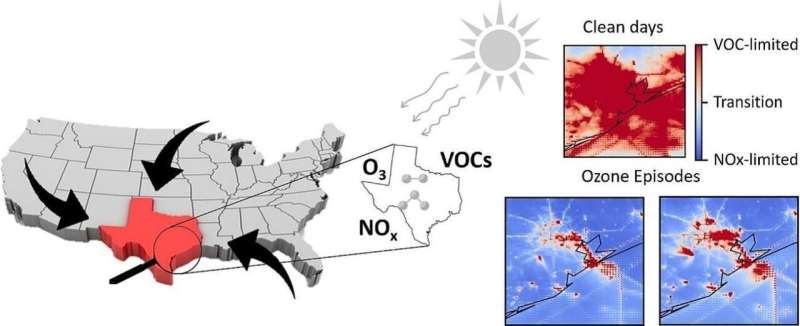This article has been reviewed according to Science X's editorial process and policies. Editors have highlighted the following attributes while ensuring the content's credibility:
fact-checked
peer-reviewed publication
trusted source
proofread
Atmospheric scientists reveal much of Houston's ozone exceedance due to air flows from the north

University of Houston atmospheric science researchers have found that while local emissions play a role in the rise of ozone levels in Houston, most of the pollutants can be carried in from other regions across the country, leading to excess ozone pollution. Their findings offer insights into strategies to mitigate future ozone pollution for the region.
The research team focused on two ozone episodes in September 2021 (Sept. 6–11 and Sept. 23–26). The month of September is the typical annual ozone peak due to high temperatures, lack of rain and air circulation patterns that transport polluted air from the north.
Their analysis revealed that roughly 63% of the excess ozone during this period was due to the transported ozone from the central and northern part of the country, while approximately 37% of the elevated ozone production was attributed to local photochemistry. The work was published in the journal Science of the Total Environment.
"Our study shows that Houston air pollution is a very complex phenomenon. There are both local and regional reasons for high ozone," said Yuxuan Wang, corresponding author and associate professor of atmospheric chemistry at UH's College of Natural Sciences and Mathematics. "Our findings also highlight that local emission control is critical."
Ozone causes muscles in the airways to constrict, leading to wheezing and shortness of breath, according to the EPA. Long-term exposure to ozone is linked to aggravation of asthma and is likely one of many causes of asthma development.
Wang's study found most of the ozone production hotspots in Houston were located over the urban core of the city and industrial districts like the Houston Ship Channel. These locations had high concentrations of nitrogen oxides (NOx) and volatile organic compounds (VOCs) generated from industry and vehicle emissions. Nitrogen oxides combined with VOCs form ozone under sunlight.
The study highlights the significant role of long-lived oxygenated VOCs on ozone formation during pollution episodes. These VOCs have atmospheric lifetimes of days to weeks, as opposed to shorter-lived VOCs that might be quickly removed from the atmosphere through chemical reactions. Examples include acetone, methanol and formaldehyde.
"These long-lived VOCs underscore the need for a heightened focus on reducing these emissions, especially at the Houston Ship Channel, since it is a hotspot of ozone formation in the area," said Ehsan Soleimanian, first author of the study and an atmospheric science doctoral student.
The team relied on rich observational data from the TRACER-AQ field campaign, a scientific experiment that measured air quality in the Houston region in September 2021 conducted in partnership with the U.S. Department of Energy, NASA and TCEQ. This data was critical for Wang's collaborators to validate their modeling.
They used computer models to simulate air movement, covering both large-scale and local circulation patterns. They also employed atmospheric chemistry models to simulate regional pollution chemistry.
"By investigating ozone pollution and examining the influence of local emissions, our study helps inform targeted strategies to enhance air quality and protect public health from ozone pollution in the Houston area," Soleimanian said.
More information: Ehsan Soleimanian et al, Understanding ozone episodes during the TRACER-AQ campaign in Houston, Texas: The role of transport and ozone production sensitivity to precursors, Science of The Total Environment (2023). DOI: 10.1016/j.scitotenv.2023.165881
Journal information: Science of the Total Environment
Provided by University of Houston




















